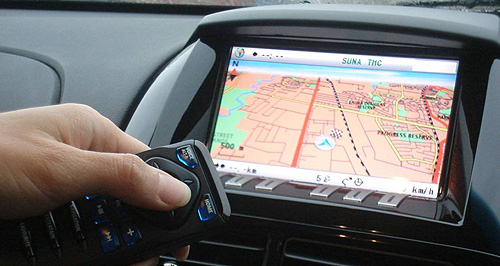Make / Model Search
News - General News - TechnologySUNA traffic monitoring gets an upgradeMore accuracy, greater coverage gives SUNA congestion-dodging technology a boost18 Nov 2011 THE 4.3 million motorists in Australia who have access to the SUNA traffic congestion alert service on their satellite-navigation devices will experience increased coverage and better accuracy in coming weeks due to a major infrastructure upgrade. Drivers in parts of New Zealand will soon also receive the service as Intelematics Australia, the company behind the locally-developed SUNA system, begins its international roll-out within the Asia Pacific region. Intelematics Australia CEO Adam Game told GoAuto enhancements to the SUNA system – which uniquely to Australia gleans much of its data from existing traffic-light sensors – mean a further 2000 kilometres of roads not controlled by traffic lights are now included in its reporting. The greater coverage is achieved by a larger fleet of ‘probe’ vehicles comprising taxis and commercial vehicles, plus increasing numbers of GPS-equipped private cars and smartphone users. Mr Game said the system had previously used probe vehicles to monitor the speed on freeways but there were now enough vehicles participating to extend coverage to arterial roads. “Wherever both technologies are available, we are intelligently fusing the information from both together to increase the precision of the service.” He said the upgraded system – dubbed SUNA 3 – can identify the highest quality data source or “fuse multiple sources to provide an aggregated result”. “We’re overlaying (traffic light sensor data) with high volumes of probe vehicle data so in a city like Sydney there are about four million speed and direction measurements each day.” Another factor in improving the SUNA service is a doubling of transmission capability in “major east coast markets”, meaning the traffic information – transmitted through the existing FM radio network – will be broadcast on two frequencies. Mr Game said the system upgrade “is all hidden from the end-user devices” and requires no action from users to receive the improved service. “Our broadcast includes alternative frequency information so if the device drops out of coverage on one frequency it is automatically able to check the alternate frequency.” SUNA is currently available in Adelaide, Brisbane, Canberra, the Gold Coast, Melbourne, Perth and Sydney. Mr Game said extending coverage to New Zealand was a priority over Darwin and Hobart, although those cities remain on his “watch list”. “Our focus is on markets where we can add value because there is significant congestion, so there is not a lot of value to be added by simply ticking the (Australian) capital city list – but it would certainly be nice to increase our footprint.” Figures supplied by Intelematics Australia reveal that more than 3.5 million SUNA-compatible devices were sold in Australia in the 2010/2011 financial year, with a further 4.5 million expected to be sold this financial year. Many aftermarket GPS brands – claimed by Intelematics Australia as representing more than 60 per cent of monthly sales – sell units supporting SUNA technology. Increasing numbers of vehicle manufacturers are offering it on their in-built satellite navigation systems, with the new Toyota Yaris being the latest addition. Mr Game said SUNA now claims 75 per cent coverage of automotive brands by market share. In addition to various Ford and Holden models, the Mercedes-Benz S-class and E-class ranges, Honda’s Insight and the Toyota HiLux now offer SUNA compatibility and GoAuto recently witnessed the system in action on a pre-production version of next year’s Lexus GS at its Melbourne reveal. “I think navigation systems being online or connected to external information is something that consumers are going to increasingly expect,” said Mr Game. Although SUNA technology is now starting to gain traction in Australia, Intelematics is already working on the next-generation system, based on the TPEG transmission standard. TPEG was conceived as a way of replicating the FM radio-based RDS-TMC system – on which SUNA and its equivalents around the world are run – over digital radio. However, the increasing number of cars with mobile data connections, either through in-built telematics systems like BMW’s ConnectedDrive or by ‘tethering’ with smartphones via Bluetooth, has led to the standard being adapted for two-way communication. Mr Game said TPEG’s higher bandwidth connection can enable compatible devices to report traffic speeds across the network, whereas RDS-TMC only reports roads that are congested. He added that TPEG also supports additional content such as fuel pricing and parking availability. Intelematics Australia is encouraging companies that produce TPEG-compatible hardware to begin testing and, because TPEG is not yet a mature standard, the company is “working with the industry to optimise it further as hardware becomes available.” Mr Game said the broadcast method is the cheaper and more scalable way of transmitting TPEG information. However, the internet method provides two-way communication, enabling vehicles to join the probe fleet and report any prevailing traffic conditions that contradict what has been received from SUNA. Intelematics Australia is also hoping to expand the availability of telematics systems beyond the realm of high-end luxury cars. Mr Game believes renewed interest in telematics technology overseas and developments like smartphone tethering mean there is a “window of opportunity”. “The movement of vehicles between countries in Europe makes a small introduction of (telematics technology) very complicated,” he said. “We are promoting Australia as a good test market and that seems to be gaining some traction in the industry.”  Read more |
Click to shareGeneral News articlesResearch General News Motor industry news |











Facebook Twitter Instagram